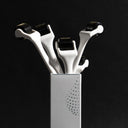You're here because you want to know does minoxidil work on your frontal baldness. You need concrete, trustworthy information by a dermatologist. Well, you're in the right place.
Frontal baldness (or temple balding) is a debilitating condition that can cause an all-out loss of hair and affects the emotional and mental well-being of the individual suffering from it.
Table of content
What is frontal baldness?
A complete loss of hair along the anterior border of the hairline is known as frontal baldness. The pattern of baldness varies in regards to the different regions of the scalp afflicted by it.
These concerned areas include; bi-temporal region, frontal hairline, mid frontal zone, and vertex. Balding in the bitemporal and vertex areas is a common complaint among men suffering from male pattern hair loss.
On the other hand, baldness is rarely associated with female pattern hair loss as women experiencing this ailment are more inclined towards diffuse thinning and overall loss of hair. Frontal baldness is also observed in people with traction alopecia and frontal fibrosing alopecia.
It can be a distressing condition that can negatively impact the mental health and self-confidence of the person suffering from it.
As your leading source for hair health information over the past 4 years, we never compromise on accuracy. When it comes to your health, you deserve information you can truly rely on - and earning your trust is our top priority.
Here's how Scandinavian Biolabs ensures every piece of content meets the highest standards of accuracy and integrity:
- Credentialed Experts: Our reviewers are actively practicing doctors and medical researchers
- Stringent Reviews: Content undergoes rigorous editing by subject specialists and review by a practicing doctor.
- Evidence-Based: We rely on well-established research from trusted scientific sources like peer-reviewed journals and health authorities.
- Full Transparency: Our editorial standards, writer credentials, reviewer credentials, correction process, and funding are all publicly documented.
- Independent Voice: While we do promote products, we operate in a vacuum to business operations. Our main goal is just an unwavering commitment to providing medically-sound guidance.
You can count on Scandinavian Biolabs to consistently deliver the trustworthy health information you deserve. Read our Editorial Standards.
What causes frontal baldness?

- Androgenetic alopecia
- Traction alopecia
- Frontal fibrosing alopecia
As mentioned above, androgenetic alopecia, traction alopecia, and frontal fibrosing alopecia are the leading reasons behind the occurrence of frontal baldness. A detailed breakdown of these conditions is given below.
Androgenetic alopecia
It is a chronic and progressive loss of hair which mostly occurs in people who are genetically predisposed to it. The incidence of male pattern hair loss is 80% in men by the age of 70 years, making it an expected case in most males.
Androgenetic alopecia initiates with a gradual thinning of hair up to the point where long terminal hair becomes scarce in the affected areas and is substituted with small vellus hair. Eventually, the frontal hairline recedes and balding becomes apparent near the temples and crown. AGA is caused by the increased activity of 5 alpha-reductase inhibitor which converts testosterone to DHT.
A surge in scalp DHT is directly associated with the lengthening of the telogen (resting) phase and miniaturization of the hair follicles. Unlike androgenetic alopecia in men, there is not enough evidence to relate hyperandrogenism with female pattern hair loss, and frontal baldness is rarely reported in women.
That's why effective DHT removal options are sought after.
Traction alopecia
Tight hairstyles including braiding, weaving, and pulling on the hair can cause strain on the frontal hairline which eventually starts to recede. This condition is known as traction alopecia.
It is usually reversible if the traction on the scalp is removed by adopting more relaxed hairstyles and by avoiding chemical treatments. However, if the strain is prolonged, traction alopecia can advance to scarring alopecia which is non-reversible and difficult to treat.
Frontal fibrosing alopecia
It is a scarring form of alopecia that causes a receding frontotemporal hairline. Frontal fibrosing alopecia has a higher incidence in postmenopausal women.
The hair follicles are progressively destroyed in this condition which results in a permanent loss of hair in the balding areas. There is not enough evidence to explain its mode of action and possible remedies.
History of minoxidil
Minoxidil was first formulated in the 1970s as an antihypertensive because of its vasodilator effect. Almost all the patients who used this drug complained of hypertrichosis and new hair growth in balding patients was also observed.
At that time, no approved and effective treatment was available for androgenetic alopecia. This led to the re-introduction of minoxidil as a hair loss remedy. It was eventually approved by the FDA for male pattern baldness in 1984. Minoxidil is now available as a foam and liquid, it also comes in 2% and 5% concentrations.
How does minoxidil treat hair loss?
Minoxidil is one of the first in line FDA-approved remedies for hair loss. The exact mode of action with minoxidil is still unclear but research proves its benefits in slowing down the progression of alopecia and inducing regrowth in dormant follicles.
The active metabolite, minoxidil sulfate, penetrates through the scalp with the help of inactive alcohol-based ingredients. Minoxidil sulfate's rate of absorption is directly linked to the amount of sulfotransferase present in the hair follicles. Due to this, the beneficial effects of minoxidil differ for each person.
- As a vasodilator, minoxidil causes a surge in the blood flow to the scalp and stimulates the production of growth factors in the dormant follicles. Consequently, an increase in the size of the miniaturized hair follicles is observed.
- Minoxidil is suspected to alter the hair growth cycle by boosting the anagen (growth) phase and in turn, shrinking the telogen (resting) phase. This causes a substantial increase in the overall hair count and density.
- Minoxidil is also responsible for the proliferation of non-vellus hair strands after 24 weeks of use. Many clinical studies done over the years display an augmentation of hair growth in androgenetic alopecia through the consistent use of both 2% and 5% minoxidil. However, 5% concentration of minoxidil shows superior results.
Can minoxidil treat frontal baldness?

If hair loss has progressed to a point of complete baldness then it’s most likely that the hair follicles have undergone a permanent change and minoxidil would be hardly effective in these areas.
However, Minoxidil is a vasodilator that is primarily used in the intervention of alopecia.
The potential benefits of minoxidil for promoting hair growth in the vertex scalp have been widely studied but its effect on the miniaturized follicles present in the other regions, including the frontal hairline, still needs more research.
A study involving 16 individuals suffering from androgenetic alopecia was asked to apply 5% minoxidil twice a day for a specified time. After 8 weeks, it was observed that the vertex and frontal scalp responded similarly to the treatment.
It should be kept in mind that discontinuation of minoxidil can induce telogen effluvium and the hair dependent on the treatment starts to shed in about 4 to 6 months so it has to be used indefinitely.
How to apply minoxidil to your hairline?
The methods of application for liquid and foam minoxidil are different. A liquid formulation usually comes in a bottle with a spray nozzle or dropper. The dropper helps in extracting the exact amount needed for treatment.
It is essential to put the product on a clean scalp.
The liquid should be rubbed gently in the affected areas with the help of fingers until fully absorbed. Remember to be careful in avoiding any dripping on the forehead or face to prevent hair growth in these places.
Foam minoxidil is available as a spray bottle and is considerably easy to use when compared to its liquid counterpart. It should be directly sprayed on the concerned areas and softly rubbed into the scalp.
Always use minoxidil according to the doctor’s prescription.
Are there any adverse effects of using minoxidil for frontal balding?

Minoxidil can potentially cause side effects that you should always consult with a doctor beforehand:
- Transient hair shedding
- Allergy
- Hypertrichosis
Transient hair shedding
Initiation of minoxidil treatment can cause an increased loss of hair during the first month. Although it might seem counterintuitive, as new hair starts to grow they push out the old strands which were in a prolonged resting period.
This causes sudden shedding as the follicles shift from a dormant phase to anagen or growth phase. Acute hair shedding in the preliminary stage indicates that minoxidil is working and it eventually resolves on its own.
Allergy
Some individuals develop an allergic reaction to minoxidil which can be caused by the drug itself or, more typically, its non-medical component propylene glycol. Itchy scalp, dandruff, and rashes are some other complaints associated with the use of this medication.
To counter this problem, a foam version of minoxidil was introduced in which propylene glycol was replaced with cetyl alcohol and stearyl alcohol. It’s recommended to perform a patch test in case of any reaction so that the responsible constituent can be identified.
Hypertrichosis
Excessive topical minoxidil administration might cause systemic absorption, resulting in excess growth of hair in other areas of the body. Those who were given a 5 percent minoxidil solution had the highest rate of hypertrichosis. It also affects female patients more frequently than male patients. Minoxidil foam can be used in place of the liquid formulation to avoid peripheral contamination.
Any adverse response to minoxidil should be informed to a health care provider as soon as possible.
What are the alternatives of minoxidil for frontal balding?
- Finasteride
- Platelet-rich plasma therapy
- Hair transplant
- Scandinavian Biolabs Hair Growth Routine
Many remedies are available to counter alopecia and improve the growth of hair. Following are some alternatives to minoxidil that can be used in combination or as a standalone treatment:
Finasteride
It is an FDA-approved antiandrogen that is employed as one of the first-in-line interventions for androgenetic alopecia. The primary role of Finasteride or Propecia is to inhibit the enzyme, 5 alpha-reductase, which is responsible for the conversion of testosterone to dihydrotestosterone.
DHT primarily acts on the hair follicles, causing them to shrink and halting hair growth. Studies show that after up to 2 years of use, Finasteride can substantially increase the hair count. It is frequently combined with topical minoxidil to treat male pattern baldness.
Dutasteride is another, more potent, 5 alpha-reductase inhibitor that was found to be effective in individuals who did not respond to Finasteride.
Platelet-rich plasma therapy
This clinical procedure involves the extraction of plasma rich in platelets from the patient and then injecting it in the affected areas of the scalp to cause a surge of growth factors. This leads to the stimulation of the proliferative state of the hair. Studies show a remarkable minimization in hair loss with up to four PRP injections.
Hair transplant
One of the best options for people with dense hair in other areas of the scalp and balding on the front is a hair transplant. In this treatment, a surgeon removes the healthy hair strands from the donor area and relocates them to the recipient region of the scalp.
This can be done through strip harvesting in which a section of the scalp is surgically extracted and each hair is separately deposited to the affected area. A downside to this procedure is that a scar is left from where the hairs are striped. Another method called follicular unit extraction entails the removal of individual follicles which are then transferred to the recipient area.
Scandinavian Biolabs Hair Growth Routine
These products are formulated with plant-powered vegan ingredients which help to nourish the hair follicle cells and improve the natural balance of the scalp. Various active components in this formula including amino acid complex, Curcuma longa, and caffeine have shown promising results in various studies.
Other benefits of these products stem from the presence of various moisturizing and protecting ingredients such as niacinamide, sodium PCA, and zinc PCA that play a vital role in maintaining scalp health.
A multipurpose approach involving a combination of various topical and oral medications is usually advised for a better response against alopecia.
Conclusion

Minoxidil displays the ability to induce hair growth in the dormant follicles and has been extensively used as a primary remedy for hair loss.
But it’s only effective in cases where the hair follicles have not sustained irreversible modification, which is a common instance in alopecia that is left untreated. That is why an early diagnosis and intervention are crucial to prevent baldness and decelerate the loss of hair.
It is important to consult with a licensed dermatologist before starting any treatment plan for alopecia.
References
- Gupta M, Mysore V (2016) Classifications of Patterned Hair Loss: A Review. J Cutan Aesthet Surg 9:3–12
- Backar S (2021) Frontal fibrosing alopecia: An overview. Journal of Skin and Sexually Transmitted Diseases 0:1–7
- Rathnayake D, Sinclair R (2010) Male androgenetic alopecia. Expert Opin Pharmacother 11:1295–1304
- Ozbas Gok S, Akin Belli A, Dervis E (2015) Is There Really Relationship between Androgenetic Alopecia and Metabolic Syndrome? Dermatol Res Pract 2015:980310
- Suchonwanit P, Thammarucha S, Leerunyakul K (2019) Minoxidil and its use in hair disorders: a review. Drug Des Devel Ther 13:2777–2786
- Billero V, Miteva M (2018) Traction alopecia: the root of the problem. Clin Cosmet Investig Dermatol 11:149–159
- McCoy J, Kovacevic M, Situm M, Stanimirovic A, Bolanca Z, Goren A (2016) Doppler laser imaging predicts response to topical minoxidil in the treatment of female pattern hair loss. J Biol Regul Homeost Agents 30:131–134
- Fabbrocini G, Cantelli M, Masarà A, Annunziata MC, Marasca C, Cacciapuoti S (2018) Female pattern hair loss: A clinical, pathophysiologic, and therapeutic review. Int J Womens Dermatol 4:203–211
- Olsen EA, Dunlap FE, Funicella T, Koperski JA, Swinehart JM, Tschen EH, Trancik RJ (2002) A randomized clinical trial of 5% topical minoxidil versus 2% topical minoxidil and placebo in the treatment of androgenetic alopecia in men. J Am Acad Dermatol 47:377–385
- Olsen EA, Whiting D, Bergfeld W, Miller J, Hordinsky M, Wanser R, Zhang P, Kohut B (2007) A multicenter, randomized, placebo-controlled, double-blind clinical trial of a novel formulation of 5% minoxidil topical foam versus placebo in the treatment of androgenetic alopecia in men. J Am Acad Dermatol 57:767–774
- Mirmirani P, Consolo M, Oyetakin-White P, Baron E, Leahy P, Karnik P (2015) Similar response patterns to topical minoxidil foam 5% in frontal and vertex scalp of men with androgenetic alopecia: a microarray analysis. Br J Dermatol 172:1555–1561
- Olszewska M, Rudnicka L (2005) Effective treatment of female androgenic alopecia with dutasteride. J Drugs Dermatol 4:637–640
- Khatu SS, More YE, Gokhale NR, Chavhan DC, Bendsure N (2014) Platelet-rich plasma in androgenic alopecia: myth or an effective tool. J Cutan Aesthet Surg 7:107–110
- Hosking A-M, Juhasz M, Atanaskova Mesinkovska N (2019) Complementary and Alternative Treatments for Alopecia: A Comprehensive Review. Skin Appendage Disord 5:72–89









